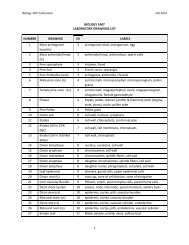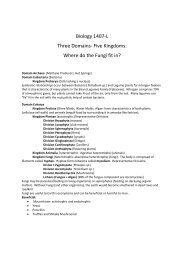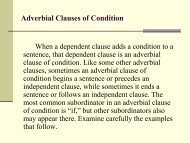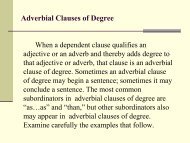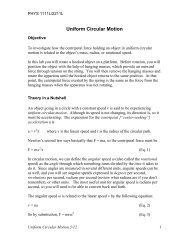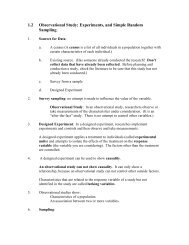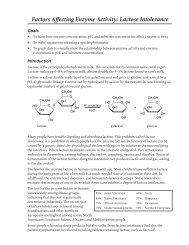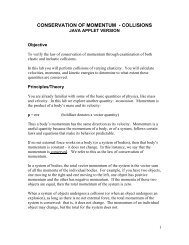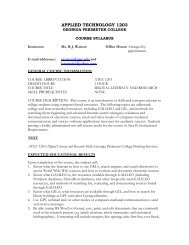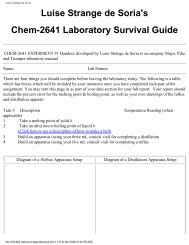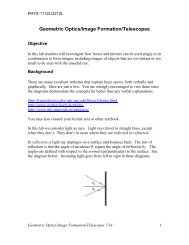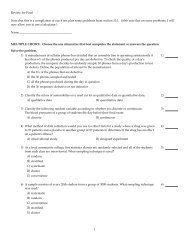Tests for Carbohydrates
Tests for Carbohydrates
Tests for Carbohydrates
Create successful ePaper yourself
Turn your PDF publications into a flip-book with our unique Google optimized e-Paper software.
<strong>Tests</strong> <strong>for</strong> <strong>Carbohydrates</strong><br />
B. Seliwanoff’s Test <strong>for</strong> Ketoses<br />
Seliwanoff’s test is used to distinguish between hexoses with a ketone group and hexoses that are<br />
aldehydes. With ketoses, a deep red color is <strong>for</strong>med rapidly. Aldoses give a light pink color that takes<br />
a longer time to develop. The test is most sensitive <strong>for</strong> fructose, which is a ketose.<br />
C. Fermentation Test<br />
Most monosaccharides and disaccharides undergo fermentation in the presence of yeast. The products<br />
of fermentation are ethyl alcohol (CH 3 CH 2 OH) and carbon dioxide (CO 2 ). The <strong>for</strong>mation of bubbles<br />
of carbon dioxide is used to confirm the fermentation process.<br />
C 6 H 12 O 6<br />
Glucose<br />
yeast<br />
⎯→<br />
2C 2 H 5 OH + 2CO 2 (g)<br />
Ethanol<br />
Although enzymes are present <strong>for</strong> the hydrolysis of most disaccharides, they are not available <strong>for</strong> lactose.<br />
The enzymes needed <strong>for</strong> the fermentation of galactose are not present in yeast. Lactose and<br />
galactose give negative results with the fermentation test.<br />
D. Iodine Test <strong>for</strong> Polysaccharides<br />
When iodine (I 2 ) is added to amylose, the helical shape of the unbranched polysaccharide traps iodine<br />
molecules, producing a deep blue-black complex. Amylopectin, cellulose, and glycogen react with<br />
iodine to give red to brown colors. Glycogen produces a reddish-purple color. Monosaccharides and<br />
disaccharides are too small to trap iodine molecules and do not <strong>for</strong>m dark colors with iodine.<br />
E. Hydrolysis of Disaccharides and Polysaccharides<br />
Disaccharides hydrolyze in the presence of an acid to give the individual monosaccharides.<br />
Sucrose + H 2 O<br />
H +<br />
⎯→<br />
Glucose + Fructose<br />
In the laboratory, we use water and acid to hydrolyze starches, which produce smaller saccharides<br />
such as maltose. Eventually, the hydrolysis reaction converts maltose to glucose molecules. In the<br />
body, enzymes in our saliva and from the pancreas carry out the hydrolysis. Complete hydrolysis<br />
produces glucose, which provides about 50% of our nutritional calories.<br />
H + or H + or H + or<br />
amylase amylase maltase<br />
Amylose, amylopectin ⎯→<br />
dextrins ⎯→<br />
maltose ⎯→<br />
many D-glucose units<br />
F. Testing Foods <strong>for</strong> <strong>Carbohydrates</strong><br />
Several of the tests such as the iodine test can be carried out with food products such as cereals, bread,<br />
crackers, and pasta. Some of the carbohydrates we have discussed can be identified.<br />
Lab In<strong>for</strong>mation<br />
Time: 3 hr<br />
Comments: Tear out the report sheets and place them next to the matching procedures. .<br />
Related Topics: <strong>Carbohydrates</strong>, hemiacetals, aldohexoses, ketohexoses, reducing sugars, fermentation



